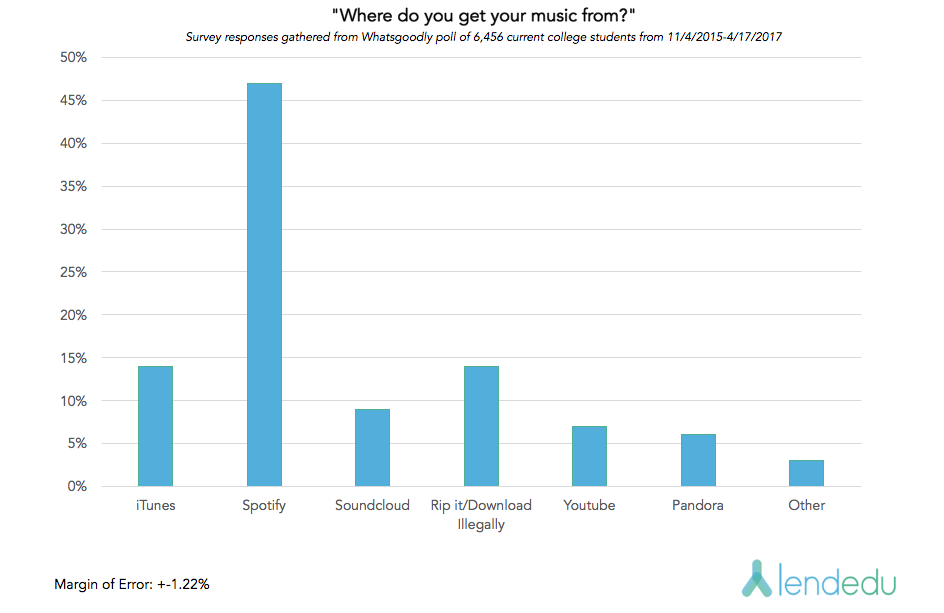Although vinyl records are making a comeback amongst trendy millennials and nostalgic baby boomers, their days of mainstream popularity are long over.
To that end, audio cassettes and CDs have been archaic music mediums for quite some time.
Today, the music marketplace is dominated by on-demand music streaming services. There is one in particular that is the most popular according to new data uncovered by LendEDU: Spotify.
LendEDU has licensed data that reveals 47 percent of millennials get their music from Spotify. For reference, the second most popular choice was a tie at 14 percent.
47% of Millennials Get Their Music from Spotify
6,456 millennials were asked the following question: “Where do you get your music from?”

Registering 47 percent of the vote, Spotify was the overwhelming winner. iTunes and “Rip it/Download Illegally” each captured 14 percent of the vote. Soundcloud received 9 percent, Youtube took home 7 percent, while Pandora got 6 percent, and 3 percent went to “other.”
While this data produced a lot of interesting takeaways, Spotify’s clear dominance in a saturated field of competition is perhaps the most intriguing.
What makes Spotify so popular amongst millennials?
For starters, Spotify is a more social music platform than any of its competitors. And, in 2017, being conducive to social media is paramount. Users’ Spotify playlists exist in the cloud and can be shared with anyone they are friends with on Facebook. Additionally, Facebook friends that use Spotify can see what one another are listening to at any given moment.
Apple Music appears to be Spotify’s biggest competitor in terms of social sharing, but even they are lagging behind. They differ in that Spotify allows users to share a track, artist, or playlist on their personal Spotify, Twitter, or Tumblr feed, while also being able to share through Facebook, email, text message, WhatsApp, or Google Hangouts. Spotify also gives users the option to “follow friends,” which shows what their friends are listening to on a continuous feed.
Apple Music does not have a feature where you can connect with fellow music listening friends. Also, with Apple Music you can only share music through text, email, Twitter, Facebook, or AirDrop, leaving subscribers with much fewer sharing options than Spotify.
Competition Copying Spotify’s Subscription Model
Another huge attraction to Spotify is the music streaming platform’s subscription based membership model. For a monthly fee of $9.99, Spotify members have unlimited access to Spotify’s music library containing over 30 million songs.
When compared to the more outdated payment systems, this model is seemingly preferred by consumers. For example, iTunes users have to pay for each individual song for a price that varies between $0.99 and $1.25.
After realizing they are losing to Spotify, other music streaming platforms are copying Spotify’s model. For example, iTunes was Apple’s main music application, but that is no longer the case; Apple created Apple Music, which has a subscription model very similar to Spotify. Apple Music users must pay $9.99, exactly the same as Spotify users.
Additionally, Pandora, another music platform featured in this poll, just recently rolled out Pandora Premium, the company’s subscription based music service. Just like Spotify and Apple Music, Pandora Premium will cost users $9.99 a month. Subscribers of Pandora’s newest service will have access to a library of over 40 million songs. Hopefully for Pandora, their millennial market share will go up because according to this poll, only 6 percent of millennials use it.
It is a common theme in the free market for competitors to copy each other, and the music streaming marketplace is no different. It was only a matter of time before Spotify’s competitors began mimicking their business model.
Popularity of iTunes, Illegally Downloaded Music Down
One of the more interesting points from this poll is that the same percentage of millennials get their music from downloading it illegally as do the people that get it from iTunes.
Signaling a decline in popularity for both, iTunes and “Rip it/Download Illegally” each received 14 percent of the vote.
It does not seem that long ago when iTunes was the premiere music streaming application. Before the age of Spotify, Soundcloud, and Pandora, everyone was using iTunes to listen to their favorite tunes. Now with so many competitors offering more bang for your buck, iTunes has taken a significant hit in usage, especially amongst millennials.
When iTunes was at its peak, a fair share of its users were actually paying the $.99 per song. However, there was also a significant contingent of people that were using iTunes, but downloading the music illegally.
“Ripping” music for free and downloading it onto iTunes used to be very common amongst music fans. File sharing programs like LimeWire and The Pirate Bay were immensely popular because they offered consumers a free and easy way to listen to the newest songs. However, according to LendEDU’s newest poll, downloading music illegally is not as commonplace as it once was.
There have been efforts to combat music piracy, and they seem to be part of the reason as to why downloading music illegally has gone down. But, it seems more likely that the plethora of affordable, quality music streaming platforms out there is the main reason why music piracy has diminished.
Platforms like Spotify, Pandora Premium, Soundcloud, and Apple Music are simply too cost efficient to revert back to downloading music illegally. Why deal with the stress and computer viruses that come with pirating music, when you can have instant access to over 30 million songs for just $9.99 a month?
The same reasoning can be applied to the lessening popularity of iTunes as well. Why pay $.99 for every song you download when you could have more than 30 million songs for only $9.99 a month?
In summation, Spotify has emerged as the trendsetter in the music streaming industry; it has simultaneously crushed iTunes and music piracy, while also pushing competitors like Apple and Pandora to copy its business model.
Methodology
LendEDU has gathered this data under license from polling company Whatsgoodly. In total, 6,456 current college students were polled from November 4th, 2015 to April 17th, 2017. The National Center for Education Statistics estimates that there are 20.5 million current college students in the United States. We estimate that our sample is representative of the population of college students with a margin of error of +-1.22%. Respondents were asked to answer the following question truthfully: “Where do you get your music from?”
See more of LendEDU’s Research
